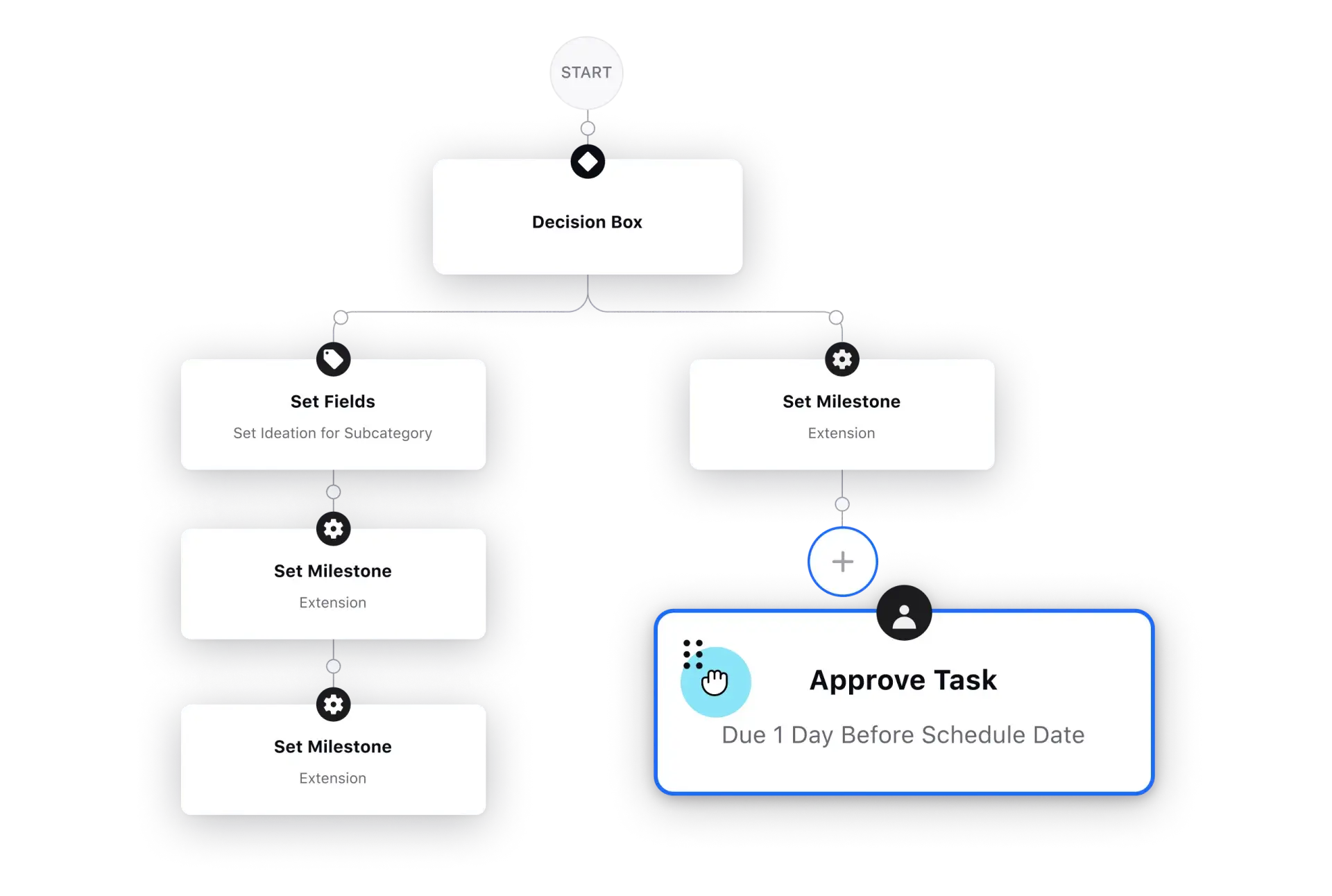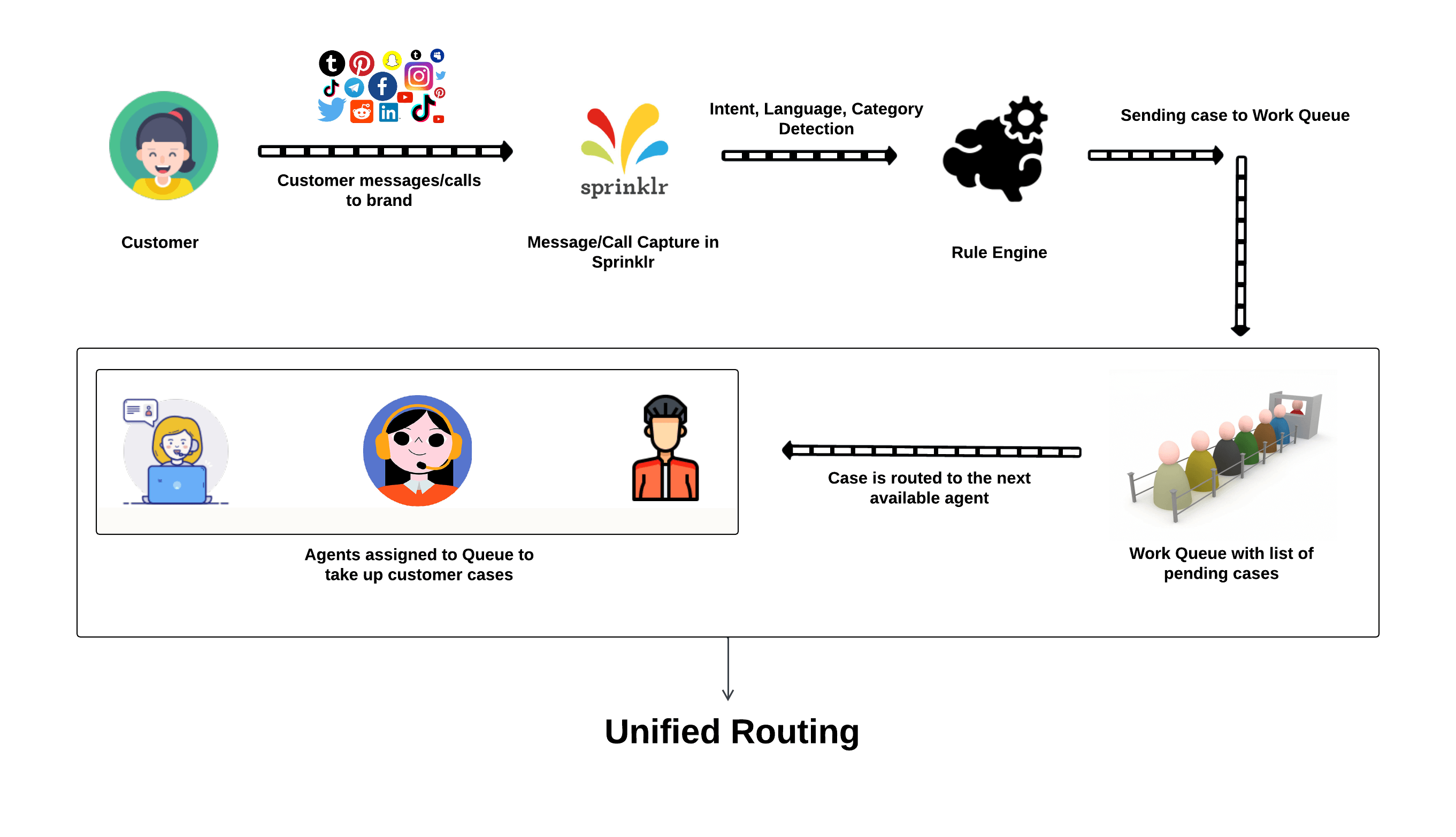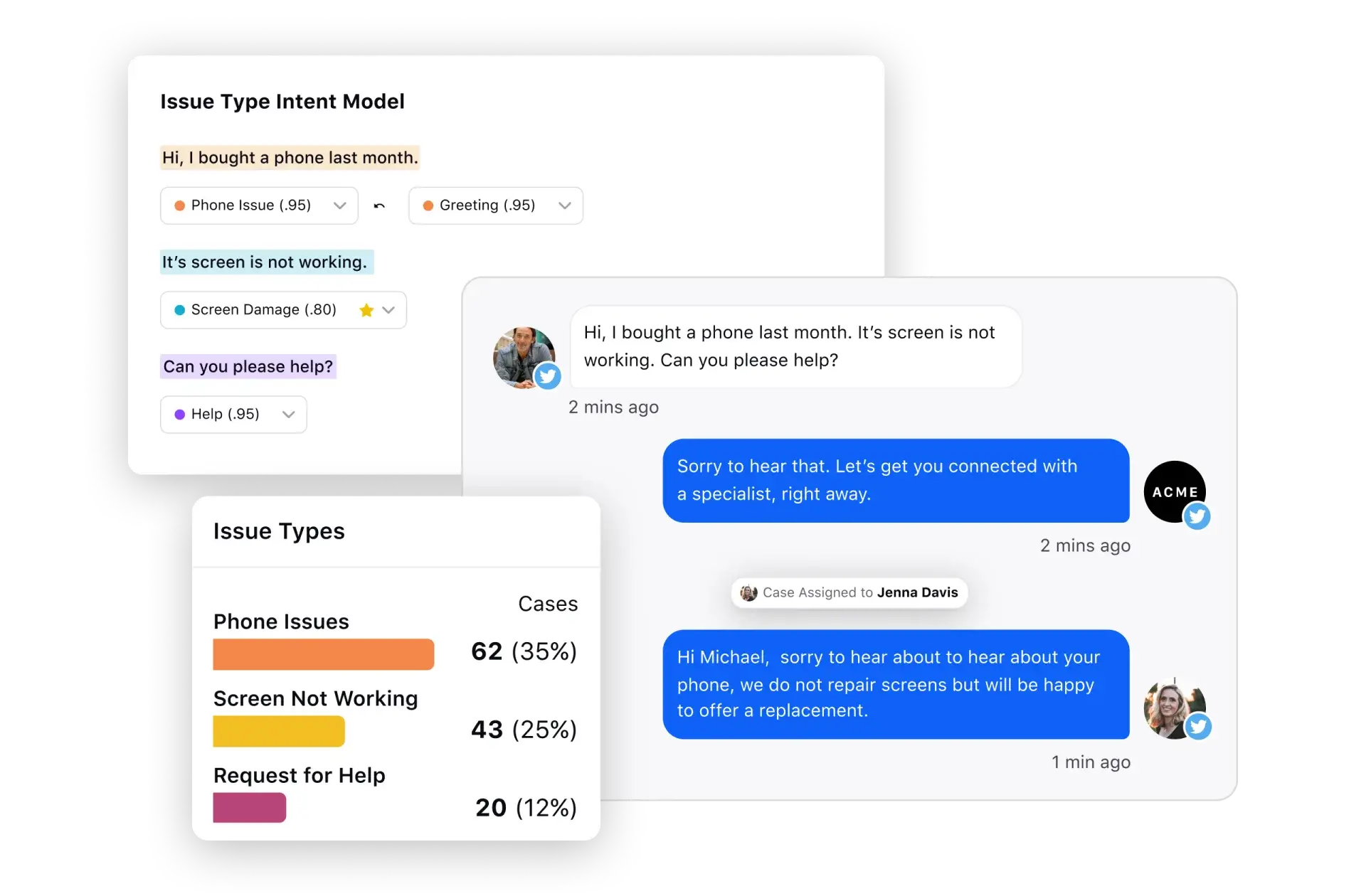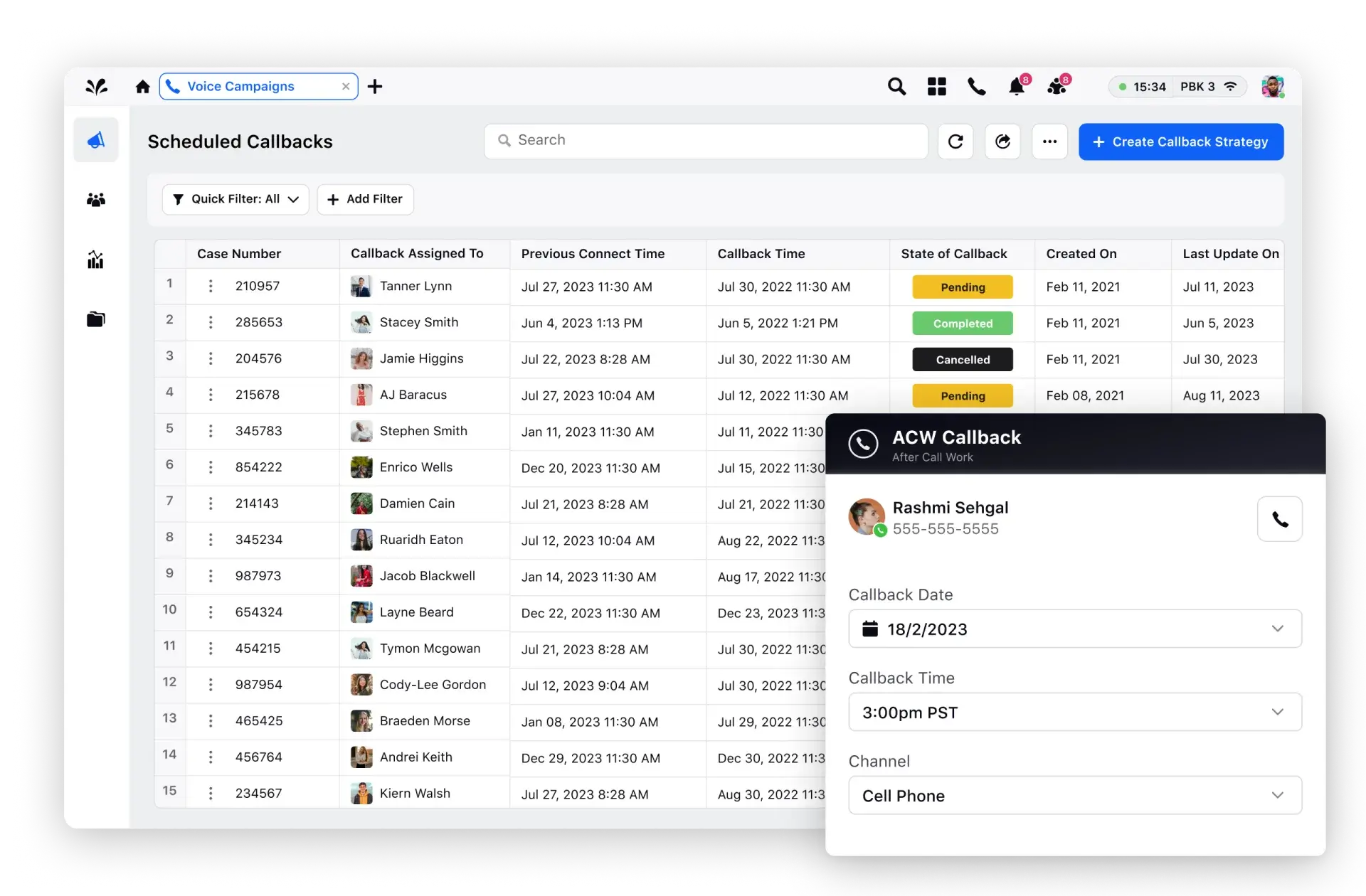- What is omnichannel routing?
- How omnichannel routing works
- Examples of omnichannel routing: Common contact center scenarios
- Benefits of omnichannel routing for contact centers
- 1. Ease of scaling
- 2. Streamlined workflows
- 3. Prioritization of high-stakes cases
- 4. Harmonious channel agnostic CX
- Deliver 30% faster resolutions with Sprinklr’s smart omnichannel routing
What is omnichannel routing?
Omnichannel routing is a contact center strategy that auto-routes customer queries intelligently across channels. Using predefined routing criteria, omnichannel routing is able to match cases to agents dynamically, regardless of the interaction channel.
Being omnichannel and intelligent, this approach enables contact centers to handle large contact volumes with restricted teams. Quick and efficient customer support leads to happier customers, productive agents and profitable operations.
To understand omnichannel routing better, picture a scenario. A customer calls a toll-free support number in a different time zone, seeking assistance. Since the call is outside regular business hours, the customer is redirected to a local agent who resolves the case in a jiffy.
The customer closes the call happily, with renewed trust in the brand. That’s omnichannel routing at work behind the scenes - moving the customer seamlessly from voice to chat, finding the shortest route to customer happiness.
Learn more: The A to Z of omnichannel customer service
How omnichannel routing works
Before we define the key components of omnichannel routing, let’s contextualize the concept.
Customer service channels have expanded beyond traditional phone calls. Customers use social media, live chat, email, review forums and many more channels to connect with brands. They expect quick responses and friction-free experiences on every channel.
An omnichannel contact center is able to centralize all contacts into a unified case queue and direct each contact to the best-suited agent, without manual intervention. The routing logic is based on criteria such as agent skill, availability and historical performance in similar cases.
Omnichannel routing functions atop certain key capabilities and features.
Routing logic governs case assignment across channels. It uses decision trees and if-then-else conditions to decide case assignments.

You can also set ticket prioritization logic to move tickets up the queue based on specific parameters. Predicted CSAT is one of the parameters that control ticket priority and escalations.
Skill-based routing is an advanced routing mechanism that matches tickets to agents having the pertinent skillset. When agents are allotted cases they can handle adeptly, resolution rates and agent productivity soar. For this to happen, agent skillsets and real-time capacity are calibrated beforehand and tagged to their profiles.
Automatic call distribution is a basic routing mechanism that diverts calls based on agent availability. It will assign an incoming call to the first available agent in the queue, no matter what their skillset or experience.
💡Pro tip: Contact center solutions like Sprinklr offer Unified Routing that leverages all kinds of algorithms – manual, ACD, skill-based – to ensure that each ticket gets its due attention, and each agent gets to work on conversations they excel at.

Dynamic capacity planning: Agent capacity is adjusted based on customer activity in the cases they are handling. In active cases, agent capacity is shown full so the routing algorithm skips them during case assignment. An idle time threshold is set so agents on inactive cases are automatically looped in for case assignment.
Conversational insights: AI can infer sentiment and intent in conversations to pinpoint underlying issues objectively. These insights give context to handling agents in cross-channel interactions.

Data integration: For quick mapping, there needs to be a free flow of customer data between frontend and backend platforms like CRM, CDP and e-commerce platforms, to name a few. Routing mechanisms use the data to identify case intent and severity accurately.
Examples of omnichannel routing: Common contact center scenarios
Being an advanced contact center technology, omnichannel routing is best demonstrated through practical scenarios. Let’s take a look at four scenarios where omnichannel routing plays a vital role in resolution delivery.
Scenario 1: A customer initiates contact through WhatsApp chat but later switches to phone.
How omnichannel routing helps
Recognizes the customer's intent to switch channels
Routes the case to a call center agent, preserving the chat context
Notifies the agent of the case history, enabling them to solve faster
The result?
A positive experience for the customer who gets assistance without repeating their case history. Support teams deliver uninterrupted assistance without information loss.
Scenario 2: A customer posts a negative review on social media and follows up via phone.
How omnichannel routing helps
Detects the post, classifies it as “engageable,” and prioritizes it internally
Routes it to an intelligent virtual agent capable of providing human-like answers
Transfers the entire case history to the handling phone agent when the customer initiates the call
The benefit?
Responsive and empathetic support on social media protects brand reputation and fosters trust.

Scenario 3: A new call enters an overcrowded call queue
How omnichannel routing helps
Looking for an available agent to handle the new call
In case of agent unavailability, the caller is presented with self-help options via IVR (interactive voice response)
If the caller chooses to wait on hold for agent assistance, the call stays in the queue
💡Pro tip: Today, there are outbound contact center solutions that offer a callback option to waiting customers. The callback is scheduled at the customer’s stated time slot, so the call-connect probability is strong.

Benefits of omnichannel routing for contact centers
Traditional routing encompasses triaging tickets manually by category, severity and other parameters, followed by ticket-by-ticket assignment to agents. It’s as cumbersome as it sounds. Omnichannel routing simplified and optimized the process for support teams which resulted in higher productivity and CSAT. There were other benefits as well, such as:
1. Ease of scaling
When teams and channels expand, it becomes tricky to manage the additional ticket inflow. Especially when new agents join the workforce, the supervisor is faced with the daunting task of scouring simple tickets for them to solve. The model is unscalable. With omnichannel routing, it’s easier to onboard new channels out of the box, without disrupting existing workflows. Skill assessment of agents is also painless. Agent skillsets and proficiency levels are automatically calibrated using AI. Tickets are tagged contextually so it becomes easy to match the right ticket to the right agent. All of this is accomplished in a matter of seconds.

2. Streamlined workflows
Omnipresent routing allows customers to interact with your brand on channels of their choice. The context and case history are maintained across channels, which helps streamline workflows for agents in a big way. There is minimal back and forth for data collection and reporting as all the pertinent information is present on a unified agent desktop.
3. Prioritization of high-stakes cases
Omnichannel routing facilitates premium support to high-value customers and VIPs. This happens through customer segmentation based on the value they bring to your business. For example, in the retail domain, loyal customers are promised priority support. They don’t need to wait in queues for live assistance, refunds or returns. With speedy support, you can transform VIP customers into staunch brand advocates who drive referrals and positive word of mouth.
4. Harmonious channel agnostic CX
The end result of all the above benefits is improved customer satisfaction and consistent customer experience. Responsive, always-on, channel-agnostic support becomes your differentiator and business driver. Customer retention improves over time with sustained efforts. If you need more compelling arguments for omnichannel routing, check out the success story in the next section. Read on.
Deliver 30% faster resolutions with Sprinklr’s smart omnichannel routing
Legacy routing mechanisms just can’t cope with case volumes in modern contact centers. With customers jumping channels rapidly and constantly, the expectation from brands is to be present everywhere with quick responses. Omnichannel routing is the answer and Sprinklr is the best provider.
Why, you ask?
Sprinklr’s customer support module – Sprinklr Service – comes loaded with Unified Routing that bundles omnichannel, automated and manual routing. Depending on your business use case and ticket volume, switch from one mode to another without big configuration changes. With Sprinklr’s routing mechanism, your resolution speed increases by 30%, owing to capabilities and features like:
Accurate sentiment and intent detection
Skill-based routing
Dynamic capacity planning
Effortless data integration
To see Sprinklr in action, request a personalized demo.
Frequently Asked Questions
Customer relationship management (CRM) includes the practices and strategies a business uses to manage and analyze customer relationships. Customer experience management (CEM) uses insights from CRM and other sources to deliver holistic, positive experiences to customers every time they interact with the brand.
Thank you for contacting us.
A Sprinklr representative will be in touch with you shortly.
Contact us today, and we'll create a customized proposal that addresses your unique business needs.
Request a Demo
Welcome Back,
No need to fill out any forms — you're all set.


